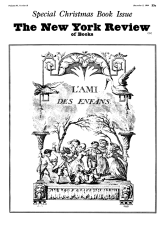Mr. de Tolnay is the author of the biggest, most learned study of Michelangelo in our generation—five volumes so far, with a sixth and final one yet to appear. Besides presenting an enormous amount of information, this large work contains many original interpretations which are extremely controversial among his scholarly colleagues. But the present small book is not, as its title perhaps suggests, a summary version of the large one. It is a special monograph on one aspect of the artist, which might be called—though the term is awkward—his ideology. The four chapters deal in succession with Michelangelo’s political, philosophical, religious, and artistic ideas. The Preface does perhaps justify the title by explaining that the book deals with these ideas “as they are revealed in his writings and in his artistic works,” but with few exceptions this monograph adds little to the relevant sections of the six-volume work.
Tolnay always challenges debate, because he draws many fresh hypotheses from material that his readers thought they knew thoroughly. Some of them, of course, are annoyed by the air of finality with which he conducts a discussion, and by the suggestion in his work that Michelangelo belongs exclusively to him. Tolnay has presented his views again and again in different contexts (large and small books, articles in professional journals, lectures, encyclopedia entries, all in many languages), and in the process, some of these views seem to have developed a self-demonstrating quality beyond their intrinsic persuasiveness.
In this book, two sections—on Michelangelo’s views on art and religion—seem to me admirable, and two—on politics and philosophy—seem questionable. The chapter on politics makes a great deal of Michelangelo’s statue of David, which is accurately described as being of a different type from the Davids of earlier Florentine sculptors, notably Donatello. But Tolnay goes further, and describes the David as having an angry expression—an interpretation different from those of many other observers. He suggests that this angry expression refers to civic virtue in the city’s struggle for freedom, and goes on to associate it with those passages in Machiavelli which call for the defense of Florence by local militia instead of mercenaries. Since Machiavelli inconveniently wrote this after the sculpture was finished, Tolnay concludes that the David anticipates “Machiavelli’s ideas.” His deductions suggest both that Michelangelo had a prophetic gift and that he deliberately expressed specific ideas in visual images. Both propositions are difficult to accept. If one disagrees that the expression of Michelangelo’s David is angry, the sculpture can then be seen to stand closer to the earlier Davids than Tolnay would have it. Moreover, earlier Florentine sculptors were suggesting David as a civic defender; and many writers before Machiavelli saw him so (as Tolnay himself remarks).
Similarly, the argument in the chapter on Michelangelo’s philosophy largely depends on The Last Judgment. Tolnay analyzes this work as having a “circular movement” of figures around the central figure of Christ. This Christ is similar to an ancient Apollo, who is the sun god, and hence, he alleges, the fresco represents the heliocentric view of astronomy—and anticipates Copernicus. This and other questionable interpretations in the same chapter, seem to me to read too much into the work. This may be the result of excessive concentration on the work itself—a critical procedure more common to literary studies than to art history.
On the other hand, the chapter on religion seems to me to show a very fine, balanced approach to Michelangelo’s ideas: the treatment of Vittoria Colonna’s influence on the artist, for example, is a great improvement over the view traditionally held by Anglo-American writers. The chapter on art is also excellent in its handling of such difficult subjects as the unfinished works, the ideal and the actual, the representation of beauty. Since religion and art are certainly more important to the “ideology” of Michelangelo than philosophy and politics, these chapters give the book its value.
This Issue
December 3, 1964



